List of Contents
Container Homes Market Size and Forecast 2025 to 2034
The global container homes market size was valued at USD 66.05 billion in 2024 and is anticipated to reach around USD 126.57 billion by 2034, growing at a CAGR of 6.72% over the forecast period 2025 to 2034. The container homes market is gaining popularity due to the rising costs of concrete houses especially in the urban areas. These houses help in managing the cost of living in the developed regions.
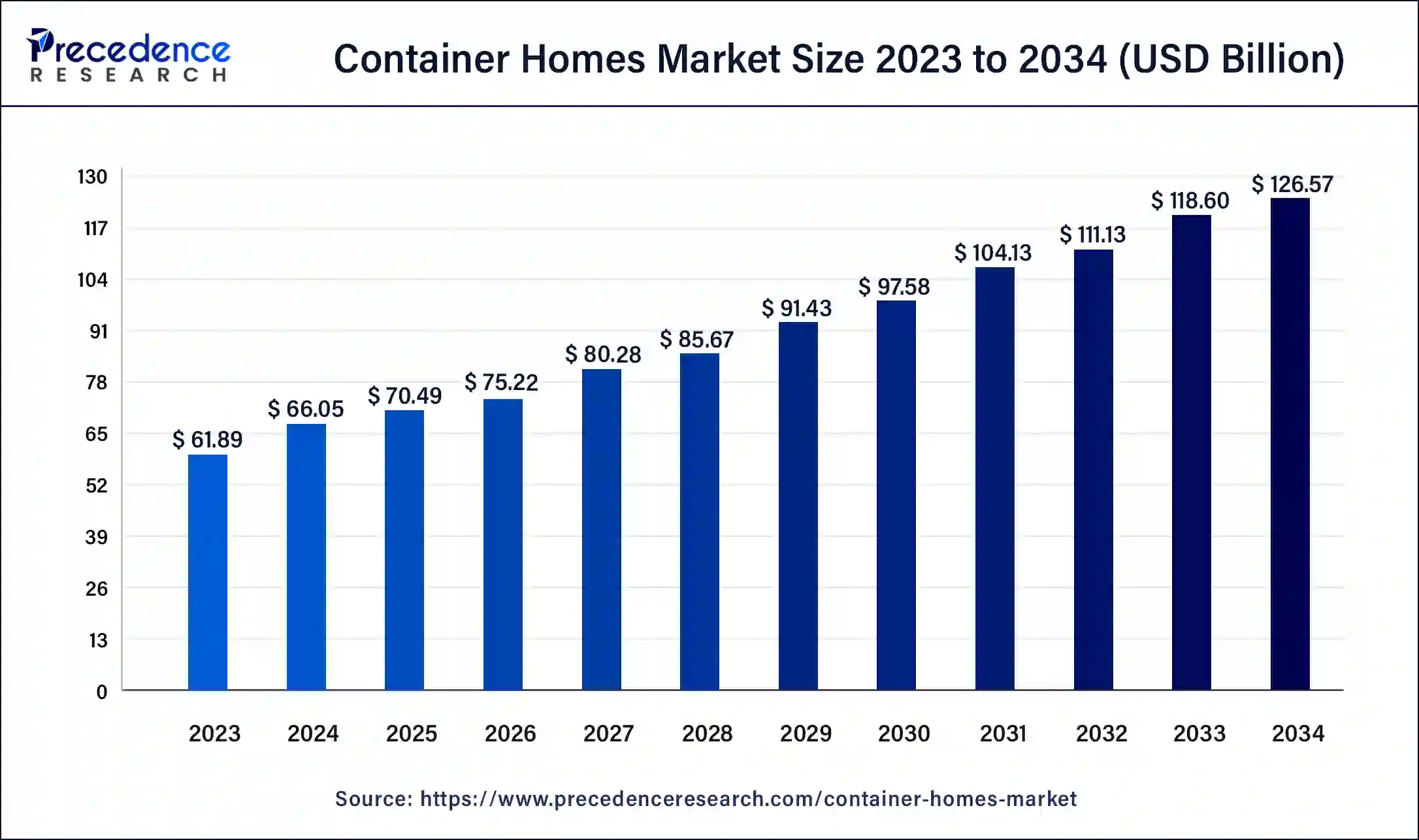
Container Homes Market Key Takeaways
- In terms of revenue, the container homes market is valued at $70.49 billion in 2025.
- It is projected to reach $126.57 billion by 2034.
- The container homes market is expected to grow at a CAGR of 6.72% from 2025 to 2034.
- North America dominated the container homes market with the largest market share of 38% in 2024.
- By type, the fixed segment dominated the global market in 2024.
- By type, the movable segment is anticipated to grow at the fastest rate in the market during the forecast period of 2025 to 2034.
- By architecture type, the tiny house segment registered a significant share of the market in 2024.
- By architecture type, the duplex/bungalow segment is expected to register notable growth in the market from 2025 to 2034.
- By end-user, the residential segment contributed the biggest market share of 49% in 2024.
- By end-user, the commercial segment is expected to grow substantially in the market during the forecast period of 2025 to 2034.
How Does AI Help in the Container Homes Market?
The rapid technological advancements have gained significant attention in multiple industries, including container homes. AI is attracting multiple industries due to its capabilities to visualize and execute new innovative ideas that help in gaining more growth in the container homes market. AI algorithms can analyze customer preferences and help in designing new container homes according to their preferences. Additionally, the robotics industry has also witnessed significant demand due to the emergence of these technologies that double up the speed of modeling these homes. The growth of augmented reality (AR) and virtual reality (VR) is also helping the consumer to visualize their homes and make changes according to their preferences.
U.S. Container Homes Market Size and Growth 2025 to 2034
The U.S. container homes market size was exhibited at USD 18.82 billion in 2024 and is projected to be worth around USD 36.79 billion by 2034, poised to grow at a CAGR of 6.91% from 2025 to 2034.
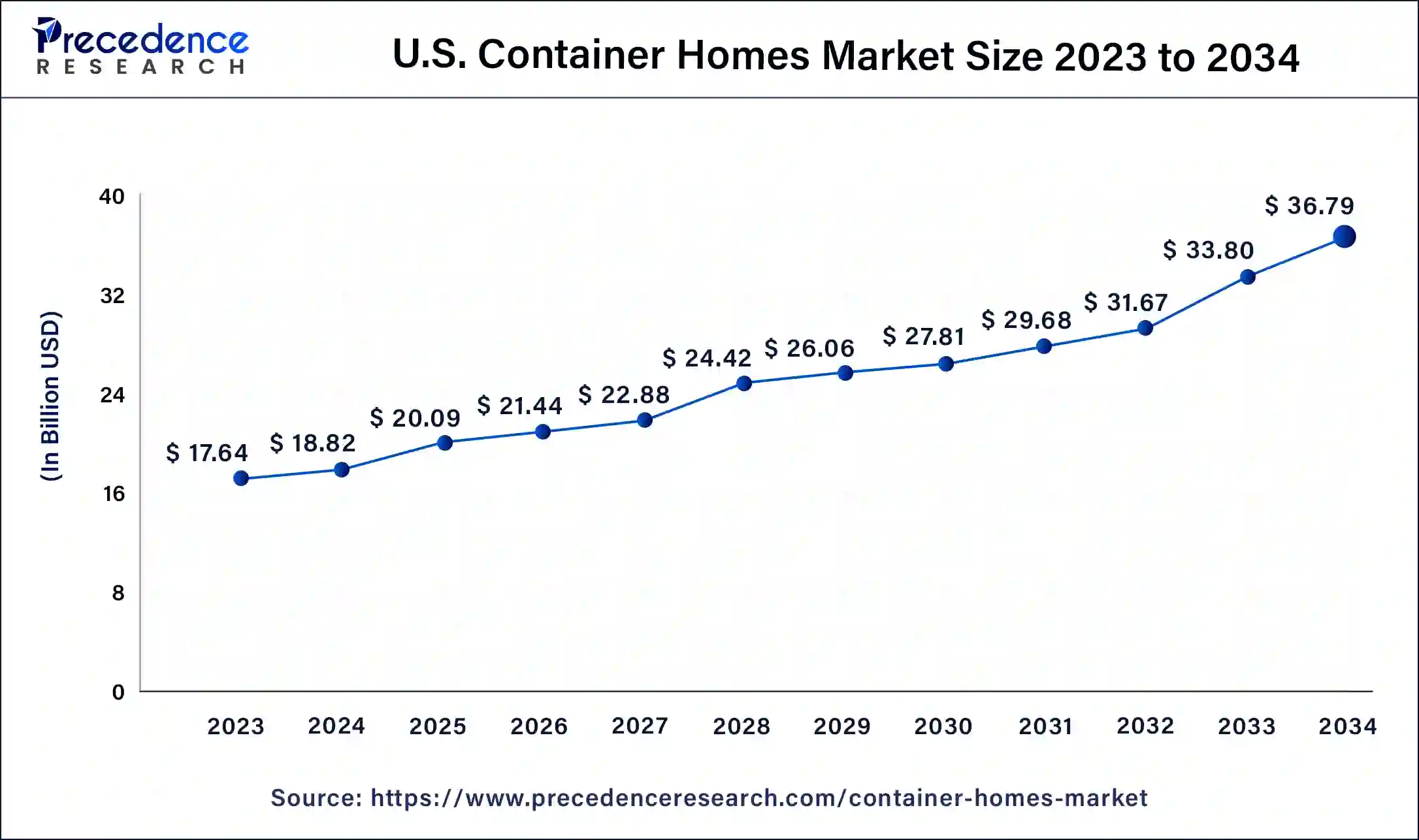
North America held the largest share of the container homes market in 2024. The region's dominance is attributed to the higher living costs in countries like the United States and Canada. These countries are also among the biggest nations that have witnessed immigrants. The increasing international population in the region is driving the need for affordable living solutions.
Additionally, the region is observed to sustain the dominance in the container homes market owing to leading towards adopting sustainable living by implementing green technologies in these homes. The rising commercial businesses in the region are leading to the demand for container homes that require less investment and higher profit margins.
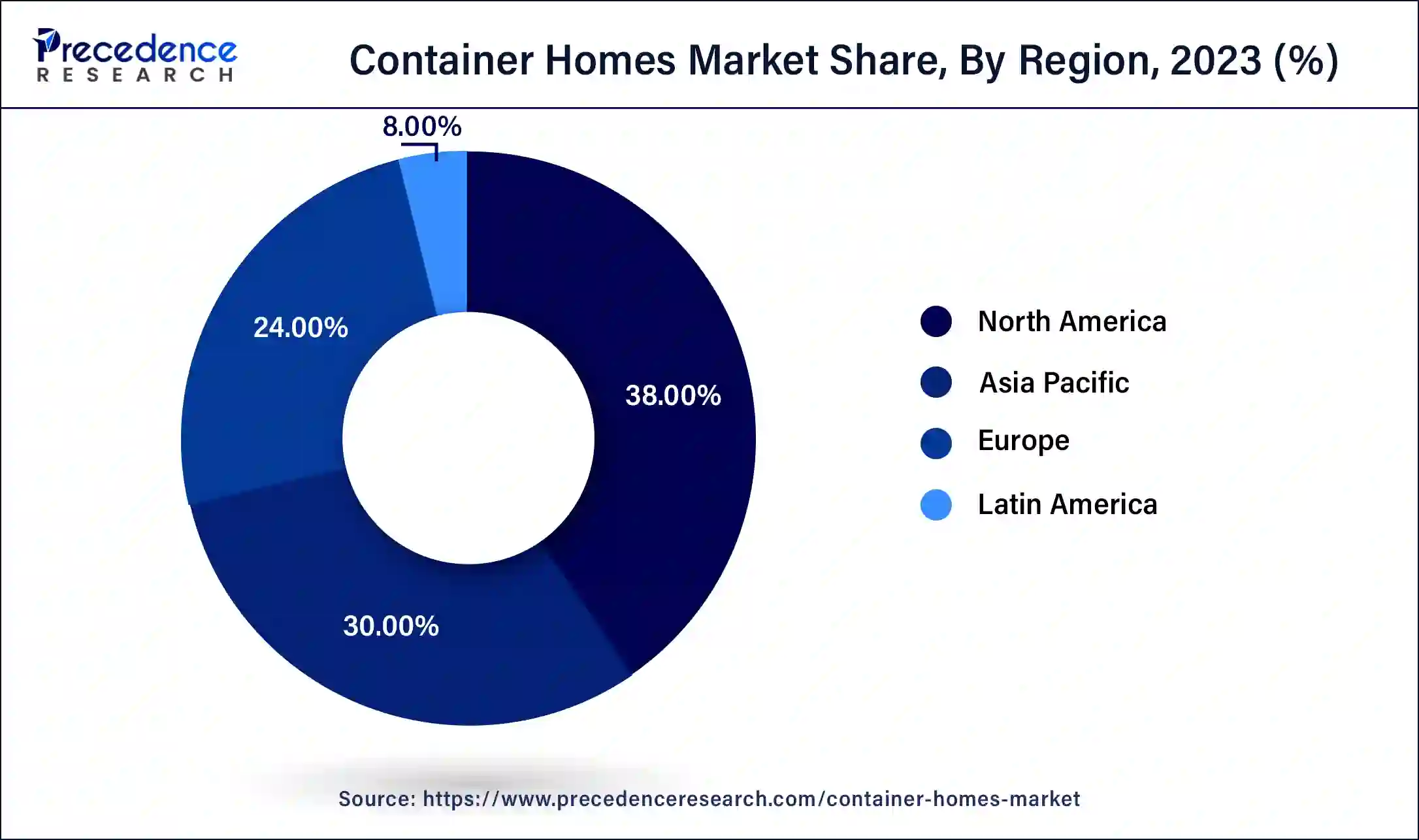
Asia Pacific is observed to grow at the fastest rate in the global container homes market during the forecast period. The region's growth in the upcoming years is attributed to one of the fastest-growing middle-class populations in countries like India, China, and Japan. This results in the need for affordable living solutions, increasing the demand for container homes. Moreover, the rising requirement of residential areas, with respect to growing urbanization is seen to promote the market's expansion.
Additionally, the growing tourism in Asian countries is one of the major factors driving the growth of the container homes market. Some of the cities in the region are facing land issues that are resulting in higher housing costs. Container homes are becoming popular in the region due to increasing government initiatives towards sustainable living. Adoption of these homes is becoming easier in the region as they require less construction time than traditional concrete-based properties.
Europe is expected to grow significantly in the container homes market during the forecast period. The growing awareness about sustainability in Europe is increasing the demand for container homes. At the same time, they are being used as they help to minimize the construction waste and promote green construction and sustainable housing. Moreover, the container homes are affordable due to which its use is increasing. Additionally, the growing urbanization is also contributing to their increased use. Thus, all these developments are promoting the market growth.
UK
The use of container homes is increasing in the UK due to the growing demand for aesthetic and stylish designs. Thus, their use in the development of customized luxurious multi-container houses is increasing. At the same time, it is also attracting the population to adopt the same. Thus, this is enhancing their use in the UK.
Germany
The population in Germany is adopting container homes to promote sustainable housing at affordable prices. This, in turn, is also supported by the government and regulatory policies. They are also supporting the development of refugee shelters as well as student dorms.
Market Overview
Container homes refer to living spaces made from shipping containers that carry goods by sea, road, and rail. These containers are typically steel-based based which can be converted into homes of all shapes and sizes. The container homes market is gaining wider popularity as a substitute for standard homes, which can be used for various purposes, such as creating multilevel residents, office spaces, and many more. They are designed in a manner that they are durable and weather resistant.
The container homes market has shown significant growth, especially after 2020, due to the rapid increase in the cost of living, especially in urban areas. All 50 States in the United States allow container homes, which are easier to build. Alaska, Tennessee, Texas, Louisiana, and California are some of the U.S. states where it is easier to build these types of residences.
Container Homes Market Growth Factors
- Rapid advancements in modular constructions are one of the major growth factors of the container homes market as they are increasing the accessibility to these shipping container homes.
- Rising popularity for off-grid living individuals is one of the major growth factors that drives the market growth.
- Increasing immigration into the urban areas is leading the demands towards temporary home solutions which stands as a major growth factor to the container homes market.
- Rapid increase in the tourism industry increases the need for eco-friendly and cost-efficient living spaces contributing towards market growth.
Market Scope
| Report Coverage | Details |
| Market Size by 2034 | USD 126.57 Billion |
| Market Size in 2025 | USD 70.49 Billion |
| Market Size in 2024 | USD 66.05 Billion |
| Market Growth Rate from 2025 to 2034 | CAGR of 6.72% |
| Largest Market | North America |
| Base Year | 2024 |
| Forecast Period | 2025 to 2034 |
| Segments Covered | Type, Architecture Type, End-user, and Regions |
| Regions Covered | North America, Europe, Asia-Pacific, Latin America and Middle East & Africa |
Market Dynamics
Drivers
Rising housing costs
The increasing real estate prices in urban areas are one of the major drivers that contribute to the growth of the container homes market. The growing population and increasing expenses lead to the increasing costs of these properties. Affording a concrete house in the developed and developing regions is not possible for low-income people, which raises the need for container homes. Additionally, there has been a drastic shift in the rural population, shifting urban areas away from their homes, which makes container homes an affordable option for them. These homes are gaining significant popularity as they can easily be relocated and modified.
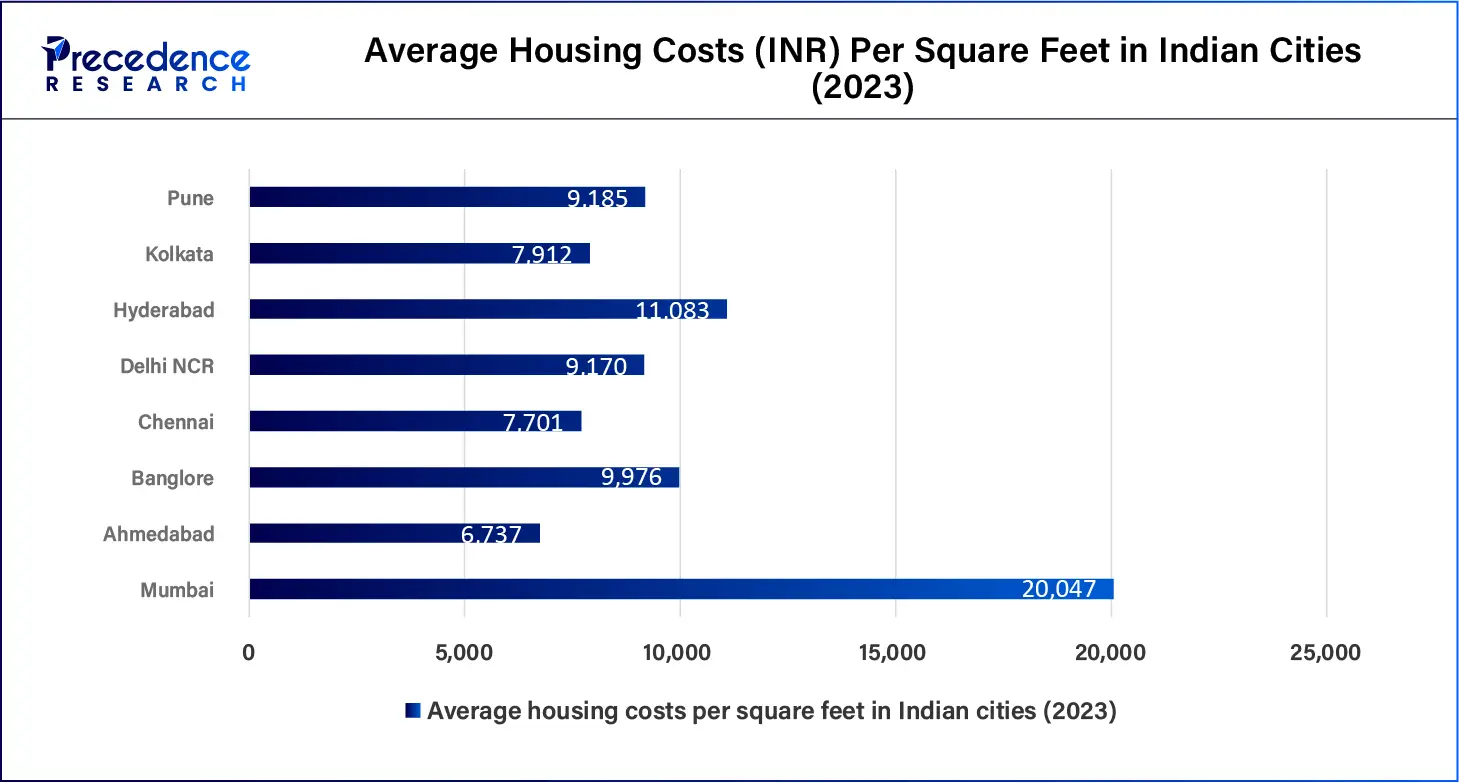
Space constraints in urban areas
The increasing population in urban areas is one of the major reasons behind rising space constraints in urban cities that lead to the growth of the container homes market. Urban regulations are witnessing changes that restrict the development of concrete houses. Container homes require less land and less time to construct, which makes them a preferable option in urban areas. These containers can be relocated, but they do not utilize the land permanently. These containers are also gaining popularity in the commercial sector as customers can use these container homes without the need for concrete land.
Restraint
Limited finance options
Container homes are a newly innovative concept that has gained popularity in recent years, but there are still some factors that tend to affect the growth of the container homes market. This newly launched concept has limited mortgage financiers who are willing to invest in these homes due to its multiple factors. This can also restrict the securing of home insurance as it is a different concept from traditional homes. Gaining popularity can play a crucial role in changing these regulations.
Opportunities
Increasing sustainable awareness
The rising environmental concerns like climate change are leading towards adopting the use of container homes as they are considered to be eco-friendly compared to concrete houses. These homes are usually made using recycled materials, which has also become a preferable option due to its nature. Governments are also promoting these eco-friendly initiatives and also help in managing the land. The adoption of the container homes market also matches the minimalism trend that promotes simple living.
Increasing adoption of smart home technologies
The increasing urban population is also changing towards different concepts of living that focus on energy management. This is leading to the implementation of solar panel controls, smart thermostats, and other green technology-based appliances that are required in home setups. The rising digitalization is also leading to the adoption of technologies that help in security and management through the use of smartphones.
Type Insights
The fixed segment dominated the global container homes market in 2024. Fixed container homes are permanent residential structures that are kept in place for a longer period. Many people who prefer container homes are adopting the use of fixed houses that ensure stability in their lives. Fixed container homes can be optimized personally by working on their security and protection from severe climatic disasters. The adoption of fixed homes also increases reliability among individuals, which helps attract more people to adopt the use of these homes.
The movable segment is anticipated to grow at the fastest rate in the container homes market during the forecast period of 2024 to 2034. The growth of the segment is attributed to the flexibility of these homes. Movable container homes refer to portable homes that can be moved easily and conveniently. These homes are often placed in tourist areas away from the city which provide a smooth nature experience to the tourists. Companies like Airbnb Vrbo are adopting the use of these container homes, making them more popular with the help of social media. These homes are lighter in weight and have less environmental impact, which makes them a convenient option.
Architecture Insights
The tiny house segment registered a significant share of the container homes market in 2024. Tiny houses refer to homes that are built under less space with minimalist designs to manage the space. These are mostly used by single living persons or small families who require less living space. These tiny houses are built at less cost than bigger homes. This makes them affordable and convenient, which helps them manage the cost of living, especially in urban areas. These houses are often promoted by many people as they are considered to be environmentally friendly.
- Amazon provides a solar-powered A-frame tiny house for under USD 10,000, offering an affordable and sustainable living option.
The duplex/bungalow segment is expected to register notable growth in the container homes market from 2024 to 2034. The growth of the segment is attributed to the adoption of container homes by multi-families. Managing living costs in multiple families, especially in urban areas, has become impossible for individuals. This increases the demand for duplex/bungalow container homes that are perfect and affordable for multi-families. The growing popularity of these homes is gaining significant attraction as a rental property.
End-user Insights
The residential segment contributed the largest share of the container homes market in 2024. The basic concept of container homes is to manage living space and expenses due to the higher cost of living. Urbanization is one of the major contributors to the increasing demand for containers for residential use. Traditional concrete-based homes are becoming unaffordable for low-income economies, which is leading to the increasing demand for container homes. Additionally, these homes contain several benefits that have gained significant attention from governments and individuals. Many people and companies are investing heavily in these homes as secondary homes that are sustainable.
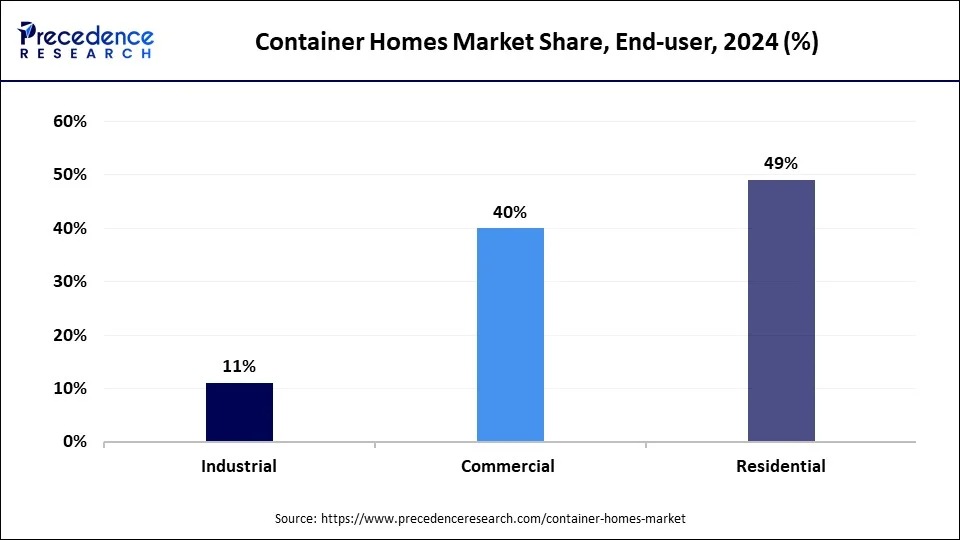
The commercial segment is expected to grow substantially in the container homes market during the forecast period of 2024 to 2034. The segment is growing rapidly due to the wider adoption of container homes for office spaces, restaurants, general stores, and others. These container homes used for these purposes require less investment than investing in a traditional concrete-based property. These homes are flexible for businesses and help them generate larger profits. Many resorts are adopting these homes in their properties, which ensures safety and saves construction costs. These homes are also gaining recognition in the healthcare sector.
- In May 2022, Mountain Home officials began exploring regulations for using shipping containers in commercial construction after receiving requests from local developers.
Container Homes Market Companies
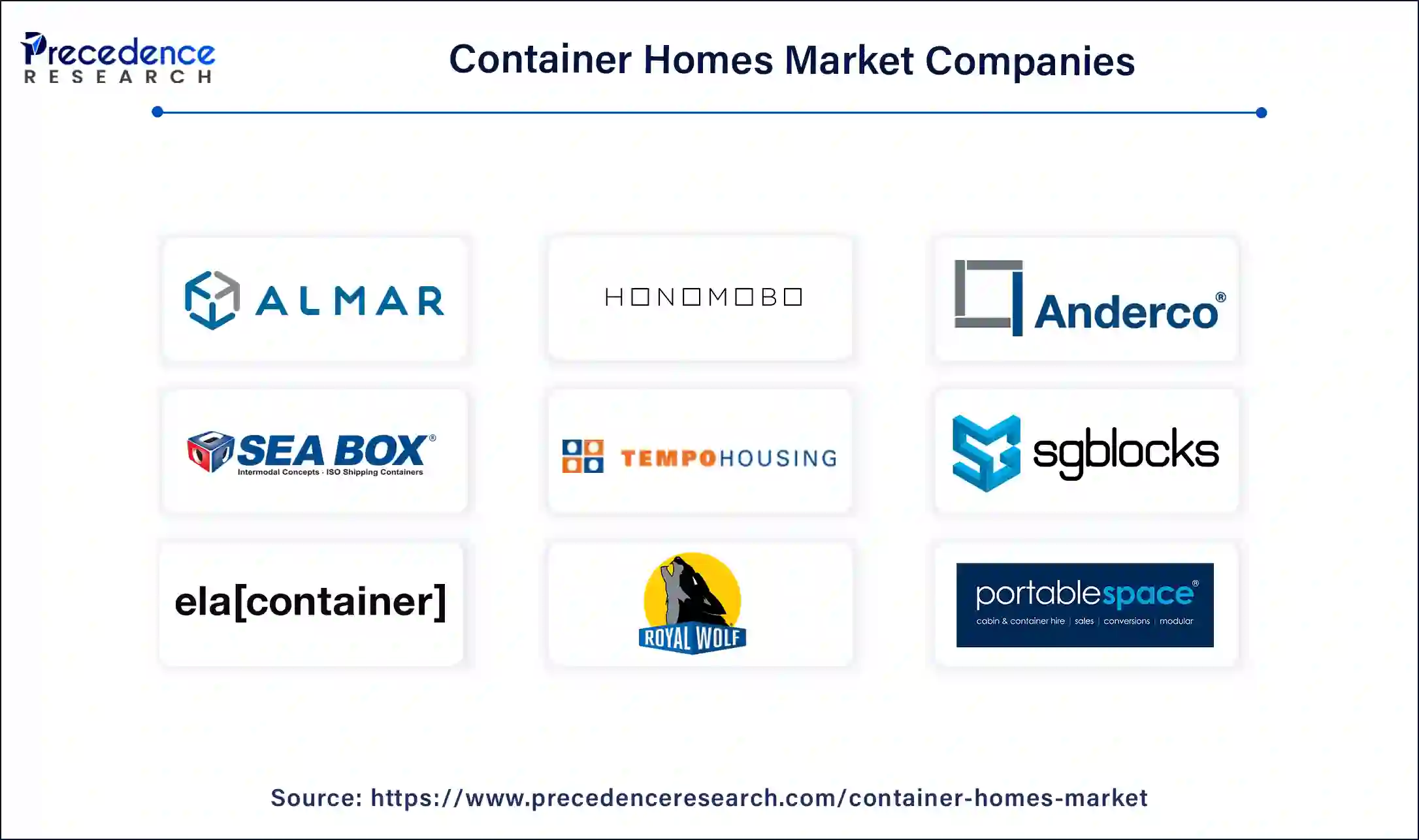
- Portable Space Ltd.
- Royal Wolf (Australia)
- ELA Container GmbH
- SG Blocks, Inc.
- Supertech Industries
- Tempohousing
- SEA BOX, Inc.
- Anderco Pte Ltd
- HONOMOBO
- Almar Container Group
Company revenue
In April 2025, preliminary financial results for the fourth quarter and fiscal year 2025 were announced by Box, Inc. The revenue and billing were recorded to be $1.090 billion and $1.110 billion, respectively. Moreover, $862.0 million, or 79.1% of revenue, was noted as non-GAAP gross profit. While the GAAP operating income was noted to be $79.6 million. At the same time, a net tax benefit of $1.06 for GAAP diluted EPS was also observed. Furthermore, a net cash of $332.3 million, up 4% which was provided by operating activities, and $304.6 million, up 13% of non-GAAP free cash flow, was recorded. Source: Box, Inc. - Box Reports Fourth Quarter and Fiscal 2025 Financial Results
Recent Developments
- In June 2024, Lorcan O'Herlihy Architects (LOHA) completed a new 54-unit supportive housing development in South LA using repurposed shipping containers.
- In January 2024, WRJ Developers started using shipping containers to build new homes in Cleveland's St. Clair-Superior neighborhood, focusing on affordable housing.
- In December 2023, Containing Luxury secured a USD 2 million Bahamas project, expanding its reach in eco-friendly container homes while raising USD 154,000 in its StartEngine crowdfunding campaign.
Segments Covered in the Report
By Type
- Fixed
- Movable
By Architecture Type
- Tiny House
- Duplex/Bungalow
- Multistory Building/Apartments
By End-user
- Residential
- Commercial
- Industrial
By Geography
- North America
- Asia Pacific
- Europe
- Latin America
- Middle East & Africa
For inquiries regarding discounts, bulk purchases, or customization requests, please contact us at sales@precedenceresearch.com
Frequently Asked Questions
Ask For Sample
No cookie-cutter, only authentic analysis – take the 1st step to become a Precedence Research client